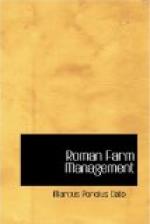“A farm would be more of a farm,” said Fundanius, “if the buildings were constructed with reference to the diligence of our ancestors rather than the luxury of their descendants. For they built for use, while we build to gratify an unbridled luxury. Their barns were bigger than their houses, but the contrary is often the case today. Then a house was praised if it had a good kitchen, roomy stables and a cellar for wine and oil fitted, according to the custom of the country, with a floor draining into a reservoir, into which the wine can flow when, as often happens after the new wine has been laid by, the fermentation of the must bursts both Spanish butts and our own Italian tuns. In like manner our ancestors equipped a country house with whatever other things were necessary to agriculture, but now on the contrary it is the effort to make such a house as vast and as elegant as possible, and we vie with those palaces which men like Metellus and Lucullus have built, to the detriment of the very state itself: in them the effort is to contrive summer dining rooms fronting the cool east, and those designed for use in winter facing the western sun, rather than, as the ancients did, to adjust their windows with regard chiefly to the cellars, since wine in casks keeps best when it is cool, while oil craves warmth. For this reason also it would seem that the best place to put a house is on a hill, if nothing obstructs it.”
Of the protection of farm boundaries
a. Fences
XIV. “Now,” resumed Scrofa, “I will speak of fences, which are constructed for the protection of the farm or for dividing the fields. There are four kinds of such barriers: natural, dead wood, military and masonry. The first is the natural fence of live hedge, consisting of planted shrubs or thorns, and, as it has roots, runs no risk from the flaming torch of the passing traveller who may be inclined to mischief. The second kind is built of the wood of the country, but is not alive. It is made either of palings placed close together and wattled with twigs, or posts placed at some distance apart and pierced to receive the ends of rails, which are generally built two or three to the panel, or else of trunks of trees laid on the ground and joined in line. The third, or military fence, consists




